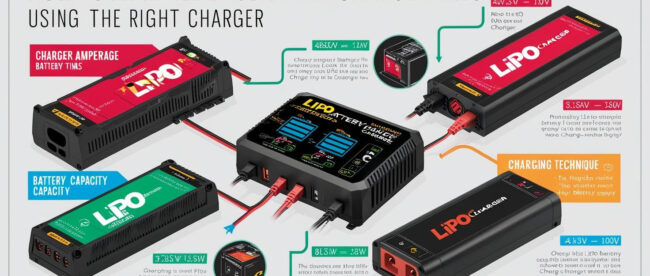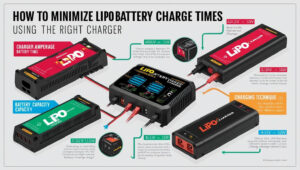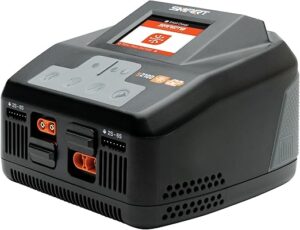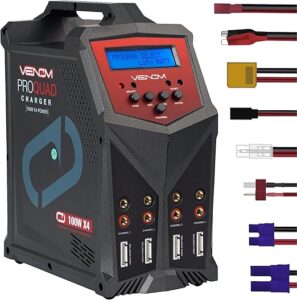How to Minimize Charge Times with the Right LiPo Battery Charger
How to Minimize Charge Times with the Right LiPo Battery Charger
When it comes to maximizing the performance and lifespan of your LiPo (Lithium Polymer) batteries, one of the most crucial factors is choosing the right charger. A fast, efficient, and reliable charger not only reduces the time it takes to power up your batteries but also ensures they stay in peak condition for longer. In this post, we’ll explore how to minimize charge times while optimizing the overall health of your LiPo batteries.
1. Choose a High-Quality Charger with the Right Output
The first step in reducing charge times is selecting a charger that matches the specifications of your LiPo battery. Every LiPo battery has a recommended charge rate, often expressed in “C” (the capacity of the battery in mAh). For instance, a 2200mAh battery with a 1C charge rate would typically charge at 2200mA (2.2A).
- Fast Charging vs. Safe Charging: Many modern LiPo chargers support faster charge rates (up to 2C or even 5C), but it’s important not to exceed the battery’s safe charging capacity. Charging too fast can cause heat buildup, leading to potential damage or reduced battery life.
- Higher Output = Faster Charging: A charger with higher current output (amps) will naturally reduce charge times. For example, a charger that supports 10A can charge multiple batteries simultaneously or charge a single high-capacity battery much faster than a 2A charger.
2. Balance Charging for Battery Health
LiPo batteries consist of multiple cells, and each needs to be charged at the same rate to maintain balance and avoid damage. Balance charging ensures that all cells within the battery are charged evenly, preventing the risk of overcharging any one cell, which can lead to swelling, heat buildup, or even cell failure.
A charger with a balance charging feature will help optimize each cell’s charge, ensuring a safe and uniform charge process. This may take a little longer than non-balanced charging, but it’s essential for keeping your battery in good shape over the long term.
3. Choose the Right Charging Profile
Many advanced LiPo chargers come with customizable charging profiles, allowing you to adjust the charging settings based on your battery type, size, and capacity. By selecting the optimal profile for your specific battery, you can prevent unnecessary overcharging or undercharging, both of which can affect charge times and battery health.
- Charge Profile Features: These often include settings for voltage, charge rate, cutoff limits, and temperature monitoring to keep everything running smoothly.
- Advanced Chargers: High-end chargers often feature microprocessor control and automatic detection of your battery’s needs, adjusting parameters in real-time to ensure the most efficient charge cycle.
4. Monitor Temperature and Avoid Overheating
LiPo batteries can get quite warm during charging, and excessive heat can shorten their lifespan or lead to dangerous situations. Good chargers come with built-in temperature sensors or have the ability to connect to external temperature probes.
By ensuring that your charger has temperature monitoring, you can avoid charging too quickly when your battery is overheating or operating outside of safe temperature ranges. While reducing charge time is important, safety should always come first. Ideally, you should always charge your LiPo batteries in a safe, well-ventilated area.
5. Use Multiple Chargers for Simultaneous Charging
If you’re working with multiple batteries, consider investing in a charger that can handle more than one battery at a time. Multi-port chargers allow you to charge several batteries simultaneously, cutting down on the total time it takes to get your gear ready for the next use.
Many chargers support parallel charging, meaning you can charge multiple batteries with the same voltage and capacity at once. However, make sure to follow the manufacturer’s guidelines to avoid issues with uneven charging or overloading the charger.
6. Regular Maintenance for Efficiency
Just like the charger, your LiPo batteries also need maintenance to perform at their best. Regularly checking for signs of wear or damage, such as puffing, dents, or leaks, is essential for safe operation. Additionally, make sure you’re following proper storage protocols (keeping your batteries at the right charge level and storing them in a cool, dry place) to keep them in good condition.
Conclusion
Choosing the right LiPo battery charger is essential to minimize charge times while improving battery performance and longevity. Look for a charger that supports your battery’s optimal charging rate, balance charging features, and temperature management to get the most out of your LiPo batteries. With the right charger, you can ensure a quicker, safer charge, reducing downtime and extending the lifespan of your batteries. Happy flying, racing, or powering your devices with confidence!
*As an Amazon Associate I earn from qualifying purchases. Thank you for your support! Click the links below to shop my favorite products! #affiliate




Leave a comment